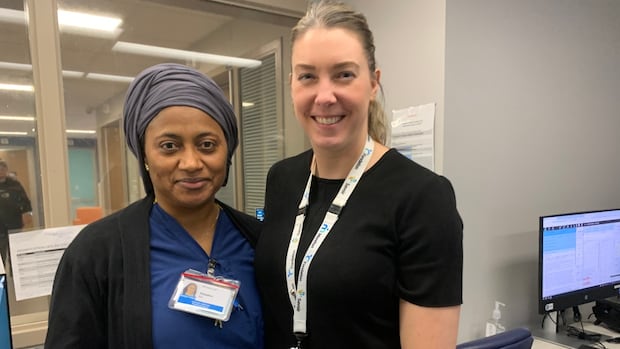White Coat Black Art26:30Giving mental-health emergency patients a room of their ownOttawa’s Montfort hospital sees twice the number of patients for mental health emergencies as the Ontario average. And as this number increased in recent years, the everyday environment of the ER waiting room – chaotic, loud and overstimulating – became an ever larger trigger, causing distressed patients to flee or harm themselves or others. In the new Mental Health Emergency Zone right off the main ER, everything has been designed for de-escalation, and staff and patients are seeing dramatic results.It’s even more hectic than usual at Ottawa’s Montfort Hospital on this Wednesday afternoon.”We have a lot of patients waiting so we can feel pressure just in the atmosphere,” said Dr. Kristine Levesque, the hospital’s deputy chief of staff and chief of psychiatry.This pressurized atmosphere is par for the course in emergency room waiting rooms, as more than 16 million Canadians who found themselves in one in 2024-2025 well know.But when Levesque enters a set of double doors just off the main ER, it’s a whole different environment.Suddenly, it’s a calm oasis with soft music, lights that can be dimmed, comfy beanbag chairs and a water cooler. There’s a bathroom with a shower and a cellphone charging locker. A psychiatric nurse is there 24/7 to do an initial assessment and de-escalate distressed patients, all the while gathering valuable information for the ER doctors.Opened in November 2024, Montfort Hospital’s Mental Health Emergency Zone (MHEZ) is purpose-built to help stabilize patients in a mental health crisis, making the ER safer for themselves, other patients and health-care workers.Up to 10 patients can be accommodated at a time in Montfort Hospital’s new secure zone, where they’re redirected straight from the main ER triage. (Montfort Hospital)The hospital sees more than twice the number of mental health emergency patients than the provincial average — eight per cent of all ER patients versus four per cent in the rest of Ontario.Situated in the Ottawa’s Rideau-Vanier neighbourhood close to a number of downtown shelters, the area has above-average rates of poverty and addiction. Montfort often sees patients suffering from substance use paired with mental health issues.”We are where people will come or where police or paramedics will bring in patients for mental health,” said Levesque. However, the increase Montfort has seen in patients experiencing psychiatric or mental-health emergencies — paired with substance use and addiction — is a Canadawide trend in hospital ERs since the COVID-19 pandemic, said Marion Cooper, president of the Canadian Mental Health Association (CMHA).The MHEZ is “all about building capacity,” said Cooper. “And I think that’s where we need all of our emergency departments to be.”Marion Cooper, president of Canadian Mental Health Association, says efforts like the Montfort Hospital’s Mental Health Emergency Zone are the right step in building a ‘mental health-care system that supports people in trauma-informed ways.’ (CMHA)Stimulating for all the wrong reasonsIn general, hospital emergency departments are not designed for mental health patients,” Cooper said.”[ERs] are very chaotic — they’re often noisy, they’re overstimulating and they can really worsen symptoms like anxiety or paranoia or even suicidal ideation. And so when the environment is actually amplifying those challenges, we know that we need to do better.”For Levesque, the push to do better was spurred by two particularly dire events that occurred in recent years.In one case, a patient died by suicide in the ER, prompting a coroner’s investigation. In another, a psychiatrist was the subject of an attempted sexual assault by a patient — one of many acts of patient aggression that Levesque said her staff members experience every year. Safe by designThe new Mental Health Emergency Zone is designed to head off off incidents like these at the pass.When the attempted sexual assault occurred, “the door did not have a spring on it to close automatically,” said Levesque. After the psychiatrist stepped out to make a call from the nursing station, the patient entered the room. Staff intervened quickly, but the event stayed with Levesque.In addition to better door closing mechanisms, there are now sensors that go off if a patient tries to wrap something around the door to strangle themselves. All hooks for hanging purses or coats are anti-ligature, so nothing can be tied to them. If the patient barricades themselves in a treatment room, staff can flip the door mechanism so it opens the opposite way. The furniture is too heavy to be lifted. And there are cameras in all rooms, so the new devoted psychiatric nurse can see everyone at all times.A nature mural works double-duty, screening the window of the nursing station and offering a sense of privacy and calm to patients in Montfort Hospital’s Mental Health Emergency Zone. (Montfort Hospital)With no government funding, the new zone is the result of a $2-million fundraising campaign by the Montfort hospital foundation — an effort that was expected to take 18 months, but instead took 18 weeks.Aissatou Bah has been a psychiatric nurse at Montfort for five years, and said the new zone is helping her do her job better.”It’s peaceful and quiet, which means I can talk to patients more easily without noise from the ER, and I can also de-escalate patients in distress,” she told White Coat Black Art’s Dr. Brian Goldman.Mental health usually ‘not the priority’ in ERsRick, 66, fell into a depressive episode last spring (we are using Rick’s first name only for privacy reasons). He and his wife went to Montfort’s ER, where they were promptly directed to the Mental Health Emergency Zone, which he said was a pleasant surprise.It was “a private area, spacious, clean, new, segregated, safe,” said Rick. “We were able to relax and not have to worry about any of the other patients.”The experience exceeded his expectations, which had been set pretty low from a lifetime of experience, Rick said.Over the last 50 years, he’s made many ER visits with his brother, who has schizophrenia. Those experiences left him with the impression that mental health is “not the priority,” said Rick.Rick said his time in the Mental Health Emergency Zone gave him the right start in getting the mental health care he needed. (Brian Goldman/CBC)But at Montfort, Rick saw the psychiatric nurse right away, followed 20 minutes later by an ER doctor, who referred him to a psychiatrist on duty. That never happened in his brother’s experience, Rick said. Rick spent a couple of weeks in treatment at the hospital’s 60-bed mental health unit before being discharged home, where he’s doing well, Levesque said. A 2-way benefit De-escalating distressed patients in a devoted zone helps staff as well. As at hospitals around the world, violent incidents affecting staff at Montfort had been steadily increasing since 2020.Data shared with CBC Radio shows that between April 2024 and March 2025, the hospital reversed the trend for the first time in five years, with 30 per cent fewer incidents compared with the previous year.Six months later, it’s 50 per cent fewer, with no incidents across the hospital during the months of May, June and August. Levesque says the new cellphone locker, which allows patients to charge and store their cellphones securely while waiting for medical attention, was a suggestion from her psychiatric nurse colleagues. (Brian Goldman/CBC)Before the zone opened in November 2024, “people didn’t want to come to work — they felt that they were taking unnecessary risks,” said Levesque, “and I don’t feel like that’s the case anymore.” Cooper said initiatives like the Montfort Mental Health Emergency Zone aren’t new, but more tailored approaches like these are encouraging.She points to the Winnipeg Crisis Response Centre, a 24/7 standalone facility opened in 2013 to divert mental health emergencies from the city’s ERs.”We’ve seen other examples emerge over the years that have really responded to that need,” said Cooper, of a “mental health-care system that supports people in trauma-informed ways.”But these approaches need to be seen across the country, said Cooper, and not just in urban centres. “Hospitals in rural and northern communities, where there are fewer resources, can look to ensure that there is access to psychiatric nurse support, peer support or family support resources.” Hospitals tend to see patients in mental health crisis more frequently in the evening or night, Cooper said. “Maybe you can’t afford 24/7 psychiatric care, but you can afford an evening shift.” The need for targeted or specialized cancer emergency treatment wouldn’t be questioned, she said.”We need to have standards of care for psychiatric and mental health crises.”
Tuesday, 11 Nov 2025
Canada – The Illusion
Search
Have an existing account?
Sign In
© 2022 Foxiz News Network. Ruby Design Company. All Rights Reserved.
You May also Like
- More News:
- history
- Standing Bear Network
- John Gonzalez
- ᐊᔭᐦᑊ ayahp — It happened
- Creation
- Beneath the Water
- Olympic gold medal
- Jim Thorpe
- type O blood
- the bringer of life
- Raven
- Wás’agi
- NoiseCat
- 'Sugarcane'
- The rivers still sing
- ᑲᓂᐸᐏᐟ ᒪᐢᑿ
- ᐅᑳᐤ okâw — We remember
- ᐊᓂᓈᐯᐃᐧᐣ aninâpêwin — Truth
- This is what it means to be human.
- Nokoma












